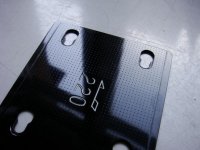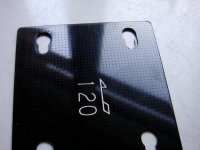Keith
The best camera is one that still works!
I have quite a few boxes of this in the freezer that I bought on the cheap a while ago but don't know a lot about the differences between it and 120
I read that it has a paper backed leader for about the first half or less then is unbacked ... to how far though? Surely the end of the film must have backing as well so you can remove it from the camera safely without exposing it to light once it's fully wound onto the takeup spool
The other question is ... can you use it in a camera designed for 120 if you block the red window and work out a system for accurate frame advancement. I read that in cameras like my Bronica RF645 the 220 setting for the camera moves the pressure plate a little close to the film rails to compensate for the lack of backing which makes sense but what about the first part of the film that still has backing? I'm a little confused about this!
The reason I ask is I have a little Voigtlander Brilliant scale focus TLR and was wondering if it's possible to use some of this 220 I have lurking in the fridge in it ... the Brilliant does have a small toothed wheel that contacts the film edge and operates a frame counter. It seems very accurate and can be reset to zero at any time by a release button. Actually this camera puzzles me a little because the red window oddly lines up with the indicators on the 120 backing for 6x9 ... it's caught me twice now and I've only got eight exposures from a roll of 120 instead of twelve. The wheel driven counter however counts and spaces accurately to twelve frames and is set back to one when you reach the first frame indicator on the film backing ... confusing also!
Sorry ...I hope you haven't nodded off while I've been describing all this! 😛
I read that it has a paper backed leader for about the first half or less then is unbacked ... to how far though? Surely the end of the film must have backing as well so you can remove it from the camera safely without exposing it to light once it's fully wound onto the takeup spool
The other question is ... can you use it in a camera designed for 120 if you block the red window and work out a system for accurate frame advancement. I read that in cameras like my Bronica RF645 the 220 setting for the camera moves the pressure plate a little close to the film rails to compensate for the lack of backing which makes sense but what about the first part of the film that still has backing? I'm a little confused about this!
The reason I ask is I have a little Voigtlander Brilliant scale focus TLR and was wondering if it's possible to use some of this 220 I have lurking in the fridge in it ... the Brilliant does have a small toothed wheel that contacts the film edge and operates a frame counter. It seems very accurate and can be reset to zero at any time by a release button. Actually this camera puzzles me a little because the red window oddly lines up with the indicators on the 120 backing for 6x9 ... it's caught me twice now and I've only got eight exposures from a roll of 120 instead of twelve. The wheel driven counter however counts and spaces accurately to twelve frames and is set back to one when you reach the first frame indicator on the film backing ... confusing also!
Sorry ...I hope you haven't nodded off while I've been describing all this! 😛



